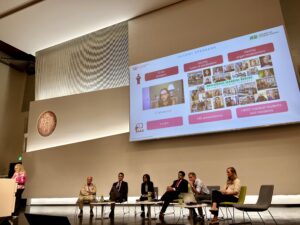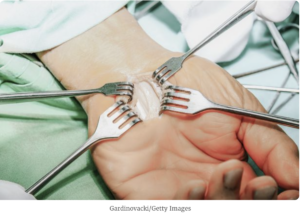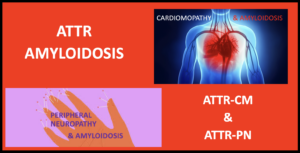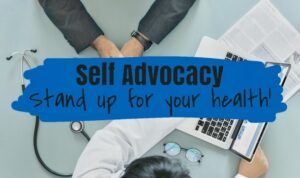We are super grateful for our growing list of supporters, many of whom are becoming repeating donors (which of course, we love), investing in our effort from year to year. THANK YOU for supporting Mackenzie’s Mission and the Amyloidosis Speakers Bureau, as without your support we could not have achieved new highs.
HOW DID WE DO IN 2021?
This was our fourth full year of operation, busy and loaded with lots of activities to advance our mission — to make a difference in the fight against Amyloidosis. Operationally, we continued to run extremely efficient and lean, and laser-focused on making a difference in two ways.
- Raising awareness about Amyloidosis, which we believe can lead to earlier diagnosis and better outcomes for patients.
- Supporting medical research on Amyloidosis, seeking the cause of the disease and more effective treatments to improve and extend lives.
RAISING AWARENESS
Amyloidosis Speakers Bureau (ASB): You may recall that back in February 2019 we launched the Amyloidosis Speakers Bureau as the cornerstone of our raising awareness effort.
Amyloidosis is considered a rare disease and is not well known. However, there is a belief within the medical community that this disease is not rare, it is underdiagnosed or diagnosed when it is too late to make a difference. The complexity of this disease makes diagnosis one of the biggest challenges affecting patient lives. It is not uncommon to hear from patients that it took multiple years and multiple doctors to ultimately arrive at a correct diagnosis, all the while the disease continued to progress. Until a cure is found, it is imperative to raise awareness within the medical community so that a diagnosis can be determined much sooner, enabling effective treatments and therapies to slow the disease progression and improve patient survival.
Our response to this crisis is the Amyloidosis Speakers Bureau (ASB), an initiative focused on educating the medical community about this disease through presentations from amyloidosis patients, an educational video from medical experts, and our monthly educational updates. Our target audience is the next generation of doctors during their first/second year of medical school, as well as residency programs for physicians launching their medical career. Of special note, we are super excited about our 2021 expansion beyond medical students to educate internal medicine residents – those new physicians beginning their career seeing patients and developing diagnostic skills. To enhance our offering for these physicians, with the help of our medical advisors we created specialized educational videos about this disease.
During 2021, we saw presentations return to pre-pandemic levels, but they remained nearly 100% virtual. With our target set at 60 presentations, we were pleased to close the year at 61 presentations to more than 2,400 medical students and resident physicians. Yay! You can read more in our ASB: 2021 Year-End Review. I hope you will take a few minutes to read the review and learn about our wonderful progress!
ASB Effectiveness and Impact Study: We have long been interested in understanding the effectiveness and impact of the Amyloidosis Speakers Bureau. With the valuable assistance from one of our speakers, Dr. Kathy Rowan, along with a Ph.D. student, we launched a pilot study in the spring 2021. The data from over 300 responses was astounding and compelling… enough to lead us to launch a formal study this fall. We are appreciative to have Dr. Vaishali Sanchorawala of Boston University serving as an expert medical advisor to our study. In 2022 we anticipate analyzing the data collected and, if informative, writing a paper and seeking publication. We are hopeful that indeed, our study will validate the power and impact from patient stories to the educational and clinical work of medical professionals.
ASB Briefs: After every presentation we invite medical students interested in continuing to learn about amyloidosis to join our ASB Briefs mailing list. Today, that list numbers over 350! Each month we send a brief discussion about some aspect of the disease with a growing library of links to informative presentations / videos by medical experts, and announcements regarding advancements in treatment. The intention is to keep amyloidosis more front-of-mind and educate on the many facets of this complex and multi-systemic disease.
Blogs: We publish periodic blogs on our website about amyloidosis on topics such as symptoms, diagnosis, treatment, expert updates, resources, and caregiver support.
Webinars: In exploring other ways to offer insightful education to our target audiences, we held our first special webinar. Attendees heard Dr. Rodney H. Falk and his patient Sean Riley (one of our ASB speakers) discuss the importance of patient/physician collaboration in diagnosis, using Sean’s personal journey to illustrate the challenges of diagnosing hereditary amyloidosis, a life-threatening rare disease that hides in plain sight. Attendees also heard Dr. Falk’s thoughts on how listening, observing, and questioning are critical to getting to a diagnosis, along with his recommendation for providers to always bring an elevated suspicion and curiosity to find answers. Here’s a link to the replay in case you’d like to view: The Power of the Patient/Physician Collaboration
A second webinar coming out of a medical school presentation focused on Wild-Type Amyloidosis. Students heard world-renowned expert Dr. Mathew S. Maurer and his patient John Basdavanos discuss John’s medical journey. Dr. Maurer provided a brief overview of Wild-Type Amyloidosis (ATTRwt), while John provided the patient perspective. Together, these insights offered a compelling story about battling a life threatening disease. Here’s a link to the replay in case you’d like to view: Wild-Type Amyloidosis – A World-Renowned Physician & His Patient
Mailings, Social Media & Miscellaneous: We spread this information across our platform which includes:
- our website, visited by over 11,500 people in 2021
- our mailing lists, with 1,375 subscribers
- our Facebook page, with over 1,225 followers
- our YouTube channel with 130 subscribers and 3,745 views of our videos in 2021
With hopes to help our communities, we co-sponsored a two-part Comfort Workshop with notable leader Jen Marr, founder of Inspiring Comfort. During the workshop, Jen, author of Paws to Comfort, shared highlights of her book, educating participants with tools and strategies for helping those around us, and ourselves, and how to comfort and connect during these challenging times.
SUPPORTING MEDICAL RESEARCH
As we have said over and over, nothing happens in research without money. And knowing the NIH currently funds only 11% of its applications, this leaves a heavy burden on private foundations and individuals to help close the shortfall gap. So, our work to raise money matters.
Monies we send to research institutions are derived from two sources: general donations to Mackenzie’s Mission and proceeds from our Play FORE The Cure charity golf tournament. This year we were thrilled to return to hosting the event, providing players with a fun 24-player Presidents Cup format, with two teams of twelve competing for the title. We’re proud to say the event this year raised over $185,000, bringing our cumulative total raise from three Play FORE The Cure tournaments to over $520,000!
To help advance medical research, a significant percentage of our monies raised was donated to four world-class research institutions.
- Mayo Clinic’s Amyloidosis Research Fund
- Boston University’s Amyloid Research Fund
- Tufts Medical Center’s Amyloid and Myeloma Research Fund
- Scripps Research’s Kelly Lab (Dr. Jeffery Kelly)
WHAT ARE OUR GOALS FOR 2022?
In short, keep doing what we are doing, but do more of it.
Raising Awareness
- Focus our energies on the Amyloidosis Speakers Bureau (ASB), expanding our medical school outreach. This is where we believe we can make the biggest impact from our efforts. Engagement from the amyloidosis patient community, securing meaningful grants, and proceeds from donations/fundraisers will be key to complement the operational and legal infrastructure required.
- Complete our data collection and analyze the responses of our ASB Effectiveness and Impact Study. If meaningful, develop a paper to submit for publication.
- Publish educational blogs to the growing medical student mailing list, as well as to our broad mailing list and website.
- Explore additional opportunities, both large and small, which enable us to further spread the word on the importance of early diagnosis.
Supporting Medical Research
- Donate a meaningful percentage of our general donations and charity golf tournament proceeds to leading research institutions whom we know are working to advance the knowledge and find answers about this disease.
WITH MUCH APPRECIATION AND GRATITUDE
You may have donated cash or securities, played in our charity Play FORE The Cure charity golf tournament, participated in one of our raising awareness campaigns, or given us a grant to support our Amyloidosis Speakers Bureau medical education initiative. You may have been an Amyloidosis Speakers Bureau speaker, liked/shared our Facebook posts, or taken the time to read our blogs to learn about amyloidosis. Whether you did one of these or many, you helped us push forward our fight against this disease and we appreciate your support.
We also want to extend a special thank you to our volunteers who passionately and graciously devote their time and expertise. Whether to help at our charity golf tournament, or one of many facets of the Amyloidosis Speakers Bureau (e.g., speaker development, running Zoom presentations, researching contacts, writing ASB Briefs, leading the charge for our ASB impact study, professionalizing our videos, and running our webinars), we can’t begin to accomplish all we have without them. Thank you!
I am encouraged by the impact Mackenzie’s Mission is already making after just a few short years. Connecting with the amyloidosis community and working together to make an impact is extremely rewarding. There is much work to be done, but with so much help from the community and our supporters I know we can win this fight!
With warm regards for a wonderful and hopeful 2022,
Mackenzie
AN UPDATE ON ME

This past year I devoted my time largely to Mackenzie’s Mission and the work of the Amyloidosis Speakers Bureau. Outside of the foundation, I work as a clinical technician at a local hospital, gaining valuable hands-on patient experience. Happily, I have been accepted into the Physician Assistant program at Northeastern University, and I can’t wait to return to my alma mater and Boston in the fall of 2022. In spite of COVID, I was able to spend a week in Iceland, taking in their breathtaking landscape and beautiful country. As for my disease, I am on a regimen that keeps my disease under control, and I continue to feel great.









